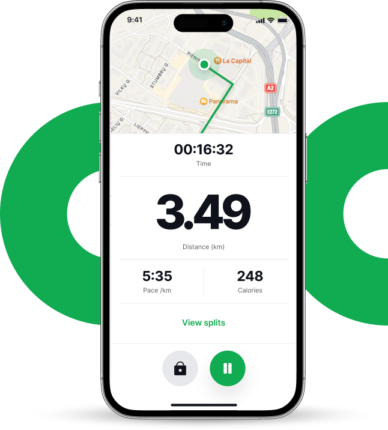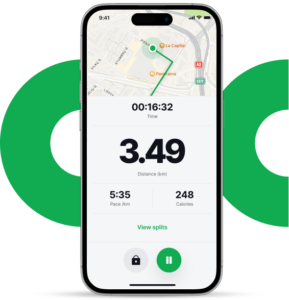Wondering how to start running? Excellent choice! From weight loss to the incredible feeling of a runner’s high, running is one of the most rewarding ways to get fit.
But let’s face it – running for beginners can feel like navigating a maze. You need to create a running plan suited to your level, and your new running routine may take some time and effort to ease into.
In This Article
In This Article:
Why should you consider starting to run
Before we jump in, I thought it would be worthwhile to go over the main benefits of running. Whether you’re seeking a challenging yet rewarding way to exercise, aiming to improve your overall health, or simply craving a natural stress reliever, running can be the perfect solution.

Physical Benefits
- Strengthens your cardiovascular system: Running promotes heart health, increases endurance, and strengthens your circulatory system, reducing the risk of heart disease and other cardiovascular conditions.
- Builds muscular strength and endurance: Running engages a wide range of muscles, particularly in your legs, core, and glutes, promoting strength, power, and overall fitness.
- Improves weight management: Running burns calories and helps you maintain a healthy weight, preventing obesity and its associated health risks.
- Enhances bone density: Running exerts a beneficial impact on bone health, reducing the risk of osteoporosis and fractures.
Mental and Emotional Benefits
- Reduces stress and anxiety: Running releases endorphins, natural mood-boosters that combat stress, anxiety, and depression, promoting mental clarity and relaxation.
- Improves sleep quality: Regular running can enhance sleep patterns, leading to deeper, more restful sleep, which contributes to overall well-being.
- Boosts self-esteem and confidence: Achieving running goals and witnessing progress can significantly boost self-esteem, instill a sense of accomplishment, and cultivate a positive mindset.
- Enhances mental focus and clarity: Running can improve cognitive function, memory, and attention span, enhancing mental sharpness and overall cognitive health.
Running is an accessible activity that can be enjoyed by people of all ages and fitness levels. With proper guidance and a gradual approach, anyone can embark on a running journey that transforms their physical and mental well-being. Embrace the power of running and discover a lifelong passion that fuels your body and mind.
Preparing for your first run
Before you put your sneakers on and get going, there are some preparations you should do beforehand, especially if you are new to running.
Know your goals
Knowing your goal can help create your running plan, keep you motivated, and provide that extra sense of reward. But for new runners, it is wise to start small. Make sure your goals are inspiring enough to keep going, but realistic and attainable without straining yourself.
Have you thought of your first race yet? A 5K run could be a fun goal, and is a great place to start. It’s a relatively easy distance to train for, allowing beginners to feel the excitement of a race and the joy of finishing it.
Choosing goals that make you feel good mentally and physically can be really rewarding, too.
For instance, you might want to fit into your favorite pair of jeans again, or simply feel more relaxed. These kinds of goals allow you to see and feel the benefits of running, which can help turn running into a habit.
Set a running plan
A balanced running plan is essential for a successful running journey. If you are out of shape or overweight, walking longer distances might be a safe place to start. Gradually transitioning from walking to running over weeks can help you build endurance, reduce the risk of injury, and make the process enjoyable rather than daunting.
Once you feel comfortable to run, follow a 10% rule of increasing your weekly mileage of no more than 10%. Alternatively, you could increase the number of days a week you hit the pavement.
If creating your own plan feels intimidating, and you’re uncertain about how to progress, an app like Joggo can create a running program for you. It takes your current fitness level, goals, and lifestyle into consideration to ensure the plan is tailored uniquely to you. Plus, you’ll be able to find warm-up and cool-down routines, expert tips, and custom-made meal plan, all in one place.

Choose the right gear and shoes
Once you’ve set your running goals and created a plan, it’s time to invest in the right gear and shoes to support your journey. Here’s a breakdown of what you’ll need:
Clothing and gear
- Lightweight and moisture-wicking running gear: Cotton clothing absorbs moisture and can weigh you down, increasing the risk of chafing. Instead, choose synthetic fabrics like polyester or nylon that wick moisture away from your body.
- Running tights or shorts: Tights provide warmth and compression, while shorts offer ventilation and flexibility. Choose a length that feels comfortable for you.
- Running shirt or top: A lightweight running shirt or top will wick moisture and keep you cool. Choose a material that feels soft and comfortable against your skin.
- Hat or visor: If you run in the sun, protect yourself from the heat and glare with a hat or visor.
- Gloves: Gloves can provide warmth and grip in cold weather. Choose gloves that are lightweight and breathable.
- Headband or sweatband: A headband or sweatband can keep sweat out of your eyes and improve your visibility.
- Water bottle or hydration pack: Staying hydrated is essential for both running and walking. Carry a water bottle or hydration pack with you to stay refreshed throughout your workout.
- Running watch or fitness tracker: A running watch or fitness tracker can track your progress, including your pace, distance, and heart rate. This can help you stay motivated and make sure you’re training effectively.
- Headlamp or reflective gear: If you run in the dark, invest in a headlamp or reflective gear to increase your visibility to other runners and motorists.
- Earbuds or headphones: Listening to music can help you stay motivated and focused during your runs. However, be sure to be aware of your surroundings and avoid using headphones if you’re running in traffic.
Running shoes
When you’re first starting out running, it’s important to choose the right shoes to support your feet and prevent injuries. Running shoes come in different types, each designed to cater to different foot types and running styles.
For beginners, it’s recommended to go for a neutral shoe, which provides a balanced amount of cushioning and support. This will help you maintain proper form and reduce the risk of overpronation or underpronation, common issues among runners.
When trying on running shoes, make sure they fit snugly but not too tightly, and there’s ample room for your toes to wiggle. You should also feel a comfortable level of cushioning and support, especially in the heel and arch areas.
Additional tips for running shoes
- Break in your shoes: New running shoes need to be broken in gradually to prevent blisters and discomfort. Start by wearing them for shorter runs, gradually increasing the distance as they soften.
- Wear properly fitted shoes: Your running shoes should fit snugly around your feet but not be too tight. You should have about a thumb’s width of space between your toes and the end of the shoe.
- Replace your shoes regularly: Running shoes tend to wear out over time, even if you don’t run very often. As your shoes wear out, they lose their cushioning and support, which can increase your risk of injury. Replace your running shoes every 300-500 miles or so, depending on your running frequency and intensity.
- Have your feet assessed: If you have any foot-related issues, such as flat feet or overpronation, it’s important to have your feet assessed by a podiatrist or running shoe specialist. They can recommend the best type of running shoes for your unique needs.
Get familiar with warm-up and cool-down routines

Warming up and cooling down are essential parts of any running routine, whether you’re a beginner or a seasoned runner. A proper warm-up will prepare your body for the workout ahead, while a cool-down will help your body recover and reduce your risk of injury.
Warm-up routine
A good warm-up should last for 5-10 minutes and include a combination of light cardio, dynamic stretching, and active flexibility exercises. Here’s an example of a warm-up routine:
- Light cardio: Start with 5 minutes of light cardio, such as jogging in place, marching, or jumping jacks. This will get your heart rate up and warm up your muscles.
- Dynamic stretching: Dynamic stretching involves moving your joints through their full range of motion. This will help to improve your flexibility and range of motion. For example, you can do arm circles, leg swings, and high knees.
- Active flexibility exercises: Active flexibility exercises involve holding a stretch for a few seconds while moving the muscle through its range of motion. This will help to improve your flexibility and range of motion. For example, you can hold a seated hamstring stretch, a standing quad stretch, and a standing calf stretch.
Cool-down routine
A good cool-down should last for 5-10 minutes and include a combination of static stretching, active flexibility exercises, and light cardio. Here’s an example of a cool-down routine:
- Static stretching: Static stretching involves holding a stretch for 15-30 seconds. This will help to improve your flexibility and reduce muscle soreness. For example, you can hold a seated hamstring stretch, a standing quad stretch, and a standing calf stretch.
- Active flexibility exercises: Active flexibility exercises involve holding a stretch for a few seconds while moving the muscle through its range of motion. This will help to improve your flexibility and range of motion. For example, you can do arm circles, leg swings, and high knees.
- Light cardio: Finish with 5 minutes of light cardio, such as jogging in place, marching, or jumping jacks. This will help to cool down your body and improve your circulation.
Benefits of a warm-up and cool-down routine
There are many benefits to warming up and cooling down before and after a run. These include:
- Reduced risk of injury: Warming up and cooling down can help to reduce your risk of injury by improving flexibility, range of motion, and muscle coordination.
- Improved performance: Warming up can help to improve your performance by increasing blood flow to your muscles and warming up your joints. Cooling down can help to prevent muscle soreness and improve recovery.
- Reduced muscle soreness: Cooling down can help to reduce muscle soreness by helping your muscles to relax and recover.
- Improved circulation: Warming up and cooling down can help to improve your circulation by increasing blood flow to your muscles.
Understand nutritional and hydration needs
Nourishing your body with the right foods and fluids is crucial for optimal running performance and long-term health. Proper nutrition and hydration support your energy levels, muscle function, and overall well-being.
Nutritional Needs
A balanced diet rich in fruits, vegetables, whole grains, and lean protein provides the essential nutrients your body needs to fuel your runs and support muscle recovery. These include:
Carbohydrates: Carbohydrates are your body’s primary source of energy, especially during running. Focus on complex carbohydrates from whole grains, fruits, and vegetables, which release energy slowly and provide sustained endurance.
Protein: Protein helps repair and rebuild muscle tissue, which is crucial for preventing injuries and promoting muscle growth. Include lean protein sources like fish, chicken, beans, and lentils in your diet.
Fats: Healthy fats, such as those found in avocados, nuts, and seeds, provide sustained energy, support hormone production, and enhance nutrient absorption.
Electrolytes: Electrolytes, such as sodium, potassium, and magnesium, are essential for regulating fluid balance, muscle function, and nerve impulses. Sweating during runs can deplete electrolytes, so replenish them by consuming electrolyte-rich foods like bananas, sports drinks, and coconut water.
Hydration
Staying hydrated is critical for running performance and overall health. Dehydration can lead to muscle fatigue, impaired coordination, and increased risk of heatstroke. Aim to drink plenty of fluids throughout the day, especially before, during, and after runs.
Pre-run hydration: Drink plenty of water in the hours leading up to your run to ensure your body is well-hydrated. Avoid sugary drinks, as they can cause energy crashes.
During-run hydration: Carry a hydration pack or water bottle to sip on water or electrolyte-rich drinks during your run. If running for longer distances, consider electrolyte tablets or powder to replenish electrolytes lost through sweat.
Post-run hydration: Rehydrate after your run to replenish fluids and electrolytes. Drink plenty of water and consider a sports drink or electrolyte-rich foods to further replenish electrolytes.
Find your running community

For many runners, one of the greatest parts of the sport is belonging to a running community. Running friends give us support, motivation, and empower us to get up and go, especially when we don’t feel like running.
The good news? Runners are everywhere, from neighborhoods and parks to city streets. You could join a road runners’ club, check out fitness apps or groups on social media. You’ll be sure to find at least one group that aligns with your goals.
Need ideas for enjoyable and fun runs? Hitting a trail can be a good way to spend time in nature and connect with your running buddies. Use an app to find a running trail near you, and make sure you have the necessary gear with you.
During and Post-run
Now when we have fully prepared for our first run, there are also some things to take into consideration during the run as well as post-run.

Try out the run-walk method
The run-walk method is a great way to gradually build up your running endurance and reduce your risk of injury. It involves alternating between running and walking intervals. Run-walk method is great for beginner runners, especially if you are overweight. This method allows you to take breaks when you need them and prevents you from getting too tired too quickly.
How to use the run-walk method
Here’s a general guideline for using the run-walk method:
- Start with a 5-minute walk to warm up.
- Run for 30 seconds, then walk for 60 seconds.
- Repeat this pattern for 10-15 minutes.
- Cool down with a 5-minute walk.
As you get stronger, you can gradually increase the duration of your running intervals and decrease the duration of your walking intervals. You can also try running for longer distances without stopping.
Avoid typical mistakes
Starting a new running program can be exciting. But you should be aware of the common mistakes most runners make in the beginning.
It may be tempting to jump right into your new routine, which can lead to overtraining, loss of motivation, or injury. Start by walking for longer periods to prepare your body for running. Alternatively, try the run walk method, and gradually build the running time. During your first weeks, keep a conversational pace while running, and don’t forget to take rest days.
Correct running technique is also crucial for injury prevention and consistent progress. Make sure you maintain proper running form – keep your upper body straight, look ahead, swing your arms from your shoulders, and engage your core. You should keep your knees slightly bent, and aim for a mid-foot strike.
Tip: Don’t underestimate the power of good running shoes. It can help ensure your foot hits the ground softly and help protect your joints from overuse injuries.
Incorporate strength training into your routine

Strength training is a crucial component of a well-rounded running routine. It helps to build muscle, improve running form, and reduce your risk of injury.
Benefits of strength training
Strength training has several benefits for runners, including:
- Builds muscle: Muscle tissue helps to burn more calories, even at rest. This can help you to lose weight or maintain a healthy weight.
- Improves running form: Strength training can help to improve your running form by strengthening the muscles that support your core, hips, and legs.
- Reduces risk of injury: Strength training can help to reduce your risk of injury by strengthening the muscles and tendons that are used in running.
- Increases endurance: Strength training can help to increase your endurance by improving your heart and lung function.
How to incorporate strength training into your routine
You can incorporate strength training into your routine in a few different ways:
- Do strength training exercises on non-running days. This will help to give your muscles and joints a chance to rest and recover from your runs.
- Do strength training exercises after your runs. This will help to improve your running form and reduce your risk of injury.
- Use free weights, resistance bands, or machines. There are many different types of strength training exercises that you can do, so you can find exercises that you enjoy.
- Start with light weights and gradually increase the weight as you get stronger. It’s important to focus on form rather than weight.
- Do 2-3 sets of 10-12 repetitions of each exercise.
- Rest for 30-60 seconds between sets.
- Be patient and consistent. It takes time to build muscle and strength.
Start running – and keep going

For new runners, getting out there and starting is crucial. But as you progress, it is equally important to establish a consistent routine and to form a sustainable running habit.
To keep your mind motivated and your body more resilient, incorporate some cross or strength training into your plan. Activities like swimming, yoga, or cycling are fun ways to switch it up while building strength and stamina.
Adopting the right mental attitude is equally important. A more positive outlook allows you to overcome obstacles more effectively, making running more rewarding. Remembering that every stride forward is a step towards a healthier, more fulfilled life.
Tip: In addition to setting goals, you could keep a health and fitness diary. It is a fun way to track your progress and can help you stay motivated.
Most common questions about starting to running for beginners
How to keep motivation up while running?
Here are a few tips to help you keep your motivation up and make running a regular part of your routine:
- Set realistic goals: Don’t try to do too much too soon. Set small, achievable goals that you can gradually increase. This will help you to feel a sense of accomplishment and keep you motivated.
- Find a running buddy: Running with a friend can help you stay accountable and make running more enjoyable. You can also motivate each other to push yourself harder.
- Vary your routine: If you’re doing the same runs all the time, you’re more likely to get bored and lose motivation. Try mixing up your routine with different types of runs, such as tempo runs, hill repeats, and fartleks.
- Listen to music: Music can help you to relax and focus on your running. Choose music that you enjoy and that is upbeat and motivating.
- Reward yourself: When you reach a goal, reward yourself with something you enjoy. This will help you to stay motivated and make running more rewarding.
- Track your progress: Keeping track of your progress can help you to see how far you’ve come and stay motivated to keep going.
- Don’t be afraid to take rest days: It’s important to give your body time to rest and recover. If you push yourself too hard, you’re more likely to get injured.
- Be patient: It takes time to build endurance and fitness. Don’t get discouraged if you don’t see results immediately. Just keep at it and you will eventually reach your goals.
How far should a beginner start running?
Beginners should start with walking and, when ready, integrate short running intervals, aiming initially for 10-15 minutes of running. As this becomes more manageable, gradually increase the duration.
The Joggo app offers personalized training plans tailored to individual needs and goals, allowing beginners to focus on their journey without the guesswork. Just let the app guide you through each step!
How to start running when overweight?
Starting to run may seem daunting, especially if you’re carrying extra weight. However, running can significantly enhance your overall health and fitness. By adopting the right approach, you can easily embark on your running journey and reap its numerous benefits.
1. Seek Medical Clearance:
Consult your physician before commencing any new exercise program, ensuring it’s safe for you. They can assess your overall health and fitness level and provide necessary clearance.
2. Embrace Gradual Progression:
If new to running, start with short, easy runs and gradually increase the duration and intensity over time. This prevents injuries and allows your body to adapt to the new activity.
3. Prioritize Proper Form:
Correct running form is crucial for safety and efficiency. Proper form minimizes injury risk and enhances running performance. Numerous resources can teach you proper form.
4. Select Suitable Footwear:
Running shoes provide support and cushioning for your feet and legs. Choose shoes tailored to your running style and foot type. Seek professional advice or consult knowledgeable staff at a running store.
5. Embrace Warm-up and Cool-down Routines:
Warming up primes your body for exercise and reduces injury risk. Incorporate light cardio, dynamic stretching, and active flexibility exercises. Cool down with static stretching, active flexibility exercises, and light cardio.
6. Fuel Your Runs:
Consume a balanced diet rich in fruits, vegetables, and whole grains. Pre-run snacks and post-run meals replenish energy stores.
7. Stay Hydrated Throughout:
Drink plenty of water before, during, and after runs to prevent muscle cramps and heatstroke.
8. Heed Your Body’s Signals:
If pain arises, stop running and rest. Pushing through pain leads to injuries.
9. Seek Support and Motivation:
Running with a friend or joining a running club provides support and motivation. Online communities also offer support.
10. Embrace Patience:
Building endurance and fitness takes time. Don’t get discouraged by slow progress; consistent effort leads to success.
How should I warm up?
Warming up before a run is essential for preparing your body for the physical demands of exercise and reducing the risk of injury. A proper warm-up increases blood flow to your muscles, enhances flexibility, and improves coordination. Here’s a comprehensive warm-up routine tailored for runners:
- Light Cardio (5-10 minutes): Begin with 5-10 minutes of light cardio, such as jogging in place or jumping jacks. This elevates your heart rate and prepares your cardiovascular system for running.
- Dynamic Stretching (5-10 minutes): Engage in dynamic stretches that mimic the movements involved in running. Examples include arm circles, leg swings, high knees, and butt kicks. Dynamic stretches enhance flexibility and range of motion.
- Active Flexibility Exercises (5-10 minutes): Incorporate active flexibility exercises that target specific running muscles. For instance, perform calf raises, hamstring stretches, and quad stretches. These exercises improve muscle suppleness and prevent tightness during and after runs.
- Focused Stretching (1-2 minutes): Conclude your warm-up with focused stretches on major running muscles. Hold calf stretches, hamstring stretches, and quad stretches for 1-2 minutes each. These static stretches further enhance flexibility and reduce post-run muscle soreness.
Remember to adjust the duration of each warm-up component based on your fitness level and running experience. As you gain experience, you can increase the intensity and duration of your warm-up.
How should I feel when I’m running?
The feeling you experience when running can vary depending on your fitness level, running experience, and the intensity of your run. However, there are some general guidelines you can follow to ensure you’re feeling good and running safely.
During your warm-up, you should feel energized and ready to start your run. Your muscles should be warm, flexible, and ready to move. You should not feel any pain or tightness.
As you start your run, you should feel a comfortable level of effort. You should be able to carry on a conversation without getting out of breath. Your heart rate should be elevated, but not to the point of feeling like you’re going to pass out.
As you continue your run, you may feel a slight burn in your muscles. This is normal and is a sign that your muscles are working hard. However, the burn should not be sharp or painful.
If you experience any pain during your run, stop and rest. Pain is a warning sign that something is wrong. It is important to listen to your body and not push yourself too hard.
After your run, you should feel refreshed and energized. Your muscles should feel sore, but not painful. You may also feel a sense of satisfaction and accomplishment.
How fast should I run?
The speed at which you run should be comfortable for you and appropriate for your fitness level and running experience. There is no one-size-fits-all answer to this question, as the best running pace will vary from person to person.
What’s proper running form?
Proper running form is essential for both efficiency and injury prevention. When you run with good form, you can run farther, faster, and with less pain.
Here are some of the key elements of proper running form:
- Posture: Keep your spine straight and tall, with your head held high and your shoulders relaxed.
- Arms: Keep your arms bent at a 90-degree angle and swing them forward and backward in a relaxed motion.
- Hips: Keep your hips level and avoid swaying back and forth.
- Knees: Your knees should be bent slightly throughout your stride. Avoid locking your knees or letting them hyperextend.
- Foot strike: Aim for a midfoot strike, landing on the middle of your foot. Avoid heel striking, which can put a lot of stress on your joints.
- Stride: Keep your stride length moderate and avoid overstriding, which can cause shin splints and other injuries.
- Breathing: Breathe naturally and rhythmically, allowing your body to set its own pace. Avoid holding your breath or taking shallow breaths.
- Shoes: Wear shoes that are properly fitted for your feet and running style.
- Surface: Run on a flat, even surface to minimize the risk of injury.
- Warm-up and cool-down: Always warm up before your run with dynamic stretches and cool down afterwards with static stretches.
What’s the best way to cool down?
A proper cool-down routine should take about 10-15 minutes. Here’s a sample cool-down routine that you can follow:
- Slow jog: Start by jogging slowly for 5-10 minutes. This will help to gradually lower your heart rate and cool down your muscles.
- Static stretches: Hold each stretch for 15-30 seconds. Focus on stretching your major running muscles, such as your quads, hamstrings, calves, and lower back.
- Active flexibility exercises: Perform dynamic stretches that mimic the movements involved in running. Examples include arm circles, leg swings, high knees, and butt kicks. These exercises help to improve flexibility and range of motion.
- Hydration: Drink plenty of water after your run to replenish fluids and electrolytes lost through sweat.
- Nutrition: Eat a snack or meal that contains carbohydrates and protein to help your muscles recover.
How often should I run?
The frequency of your running routine depends on your fitness level, running experience, and goals. However, there are some general guidelines that can help you determine how often you should run.
Beginner runners:
- Start with 2-3 runs per week: This will allow your body to adapt to the new activity and reduce the risk of injury.
- Gradually increase the number of runs per week: As you get fitter, you can increase the number of runs up to 4-5 per week.
Intermediate runners:
- Run 3-5 times per week: This will help you maintain your fitness level and improve your running performance.
- Vary your running routine: Alternate between easy runs, tempo runs, and interval training.
Advanced runners:
- Run 4-6 times per week: This will allow you to train for more challenging races and events.
- Incorporate strength training into your routine: This will help you build muscle and prevent injuries.
Takeaways
Still unsure how to start jogging today? Getting started is the most challenging part. But once you overcome the initial inertia, maintaining a regular running habit can add a sense of well-being and accomplishment to your life. Here are a few things to keep in mind before you take that first step:
- Set realistic, yet inspiring goals. You could start from a 5K race to maybe a half marathon, depending on your fitness level and the time you’re willing to allocate for running.
- Start small. A safe running plan for beginners might begin with brisk walking, and gradually increase to longer running intervals. Run at an easy pace first, and remember – it’s ok to take walk breaks!
- Mix it up with some cross training to avoid boredom. Add yoga, swimming, or cycling or some other activity you like to your routine. Experimenting with running workouts can be fun, too.
- Get comfortable gear you would enjoy wearing. Activewear you love can motivate you to get out there and run.
- Be mindful of your running technique – keep your body upright, breathe deep through your nose, land your foot lightly. Also, avoid overtraining to ensure consistent progress.
- A positive attitude can help in overcoming challenges and making the running experience more rewarding.
- Establish a balanced running plan. Beginners starting out at a level unsuited to their needs often risk injury or loss motivation.
Looking for some guidance to kickstart your fitness journey? Try Joggo – a digital running coach that creates a running program around your goals, needs and lifestyle. Take our free, 2-minute quiz and start building a plan that guides, motivates, and evolves with you.
References:
- Conraads, V.M., De Sutter, J., Roeykens, J. and Sharma, S., 2009. (Don’t) just start running. European Journal of Cardiovascular Prevention & Rehabilitation, 16(2_suppl), pp.S11-S13.
- Do, W.W.C., How to Start Running.
- Malchrowicz-Mośko, E., León-Guereño, P., Tapia-Serrano, M.A., Sánchez-Miguel, P.A. and Waśkiewicz, Z., 2020. What encourages physically inactive people to start running? An analysis of motivations to participate in Parkrun and City Trail in Poland. Frontiers in Public Health, 8, p.581017.
- Mishra, S.C., 2015. REASONS RUNNING IS GOOD FOR YOU. Deliberative Research, 26(1), p.59.
- Fokkema, T., Hartgens, F., Kluitenberg, B., Verhagen, E., Backx, F.J., van der Worp, H., Bierma-Zeinstra, S.M., Koes, B.W. and van Middelkoop, M., 2019. Reasons and predictors of discontinuation of running after a running program for novice runners. Journal of Science and Medicine in Sport, 22(1), pp.106-111.














